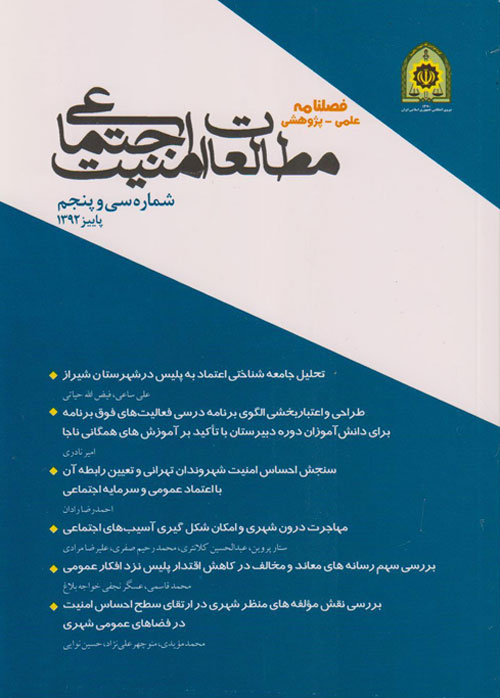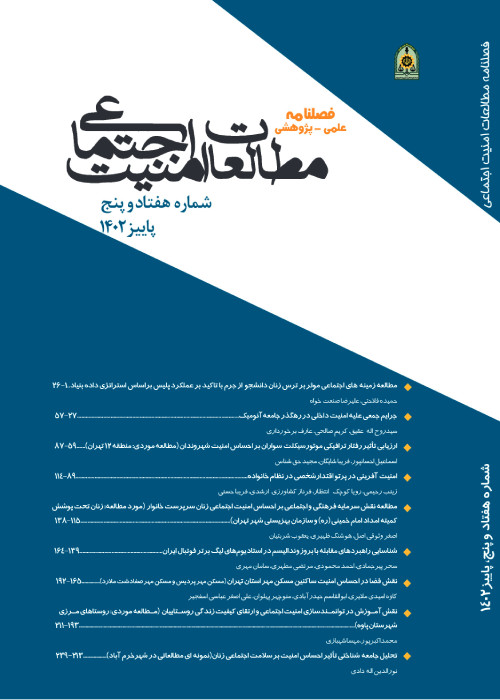فهرست مطالب

فصلنامه مطالعات امنیت اجتماعی
سال سوم شماره 2 (پیاپی 30، تابستان 1391)
- تاریخ انتشار: 1391/06/21
- تعداد عناوین: 2
-
-
صفحات 119-142
مقاله ی حاضر با استفاده از روش پیمایشی به بررسی توصیفی چهار بعد از امنیت اجتماعی در شهر سبزوار م یپردازد. این ابعاد عبارتند از احساس امنیت جانی، مالی، آبرو و حیثیت اجتماعی و احساس امنیت در معابر شهری. آنگاه رابطه متغیر امنیت اجتماعی را با برخی عوامل اجتماعی، اقتصادی و جمعی تشناختی از جمله اعتماد اجتماعی، احساس عدالت اجتماعی، پایگاه اجتماعی اقتصادی، سن، جنس، محل تولد، وضعیت تاهل و مهاجرت، مورد بررسی قرار م یدهد. نتایج نشان م یدهد که پاسخگویان بیشترین احساس امنیت را در بعد جانی دارند و ابعاد آبرو و حیثیت اجتماعی، مالی و احساس امنیت در معابر شهری در مرتب ه های بعدی قرار دارد. به علاوه متغیرهای جنسیت، محل تولد، تحصیلات، احساس عدالت اجتماعی و اعتماد اجتماعی با احساس امنیت اجتماعی رابطه معن یداری دارند. بدین معنی که مردان، متولدین روستا، افراد با تحصیلات پایینتر، افرادی که احساس عدالت اجتماعی بیشتر میکنند و افراد دارای اعتماد اجتماعی بیشتر، از احساس امنیت اجتماعی بالاتری برخوردارند. نتایج رگرسیون چند متغیره نشان می دهد که دو متغیر احساس عدالت اجتماعی و اعتماد عمومی به ترتیب وارد مدل شده و مجموعا 17 درصد از تغییرات متغیر وابسته را تبیین می کنند. از این رو می توان استنباط کرد که امنیت اجتماعی صرفا یک پدیده سخت افزاری نیست که فقط با نیروی کنترل گر تامین شود و متغیرهای نرم افزاری، زمینه ی اصلی را شکل می دهد که در آن امنیت اجتماعی شکل می گیرد.
کلیدواژگان: امنیت اجتماعی، عدالت اجتماعی، اعتماد عمومی، سبزوار -
صفحات 143-178زمینه و هدف
از جمله مسایل و مشکلاتی که امروزه، آسایش عموم مردم را در شهرهای بزرگ به مخاطره انداخته، مساله وقوع و افزایش آمار جرایم ناشی از تخلفات رانندگی است. پژوهش حاضر با هدف پیش بینی رفتار رانندگی براساس ویژگی های شخصیتی و هیجان خواهی به اجرا در آمد.
روشجامعه آماری این تحقیق، کل رانندگان شهرستان اردبیل بود. در این تحقیق 160 راننده موتور سیکلت، ماشین های سنگین، نیسان و سواری از طریق روش نمونه گیری در دسترس انتخاب و مورد مطالعه قرار گرفت. برای جمع آوری اطلاعات از پرسشنامه های رفتار رانندگی منچستر، پرسشنامه شخصیتی نئو و هیجان خواهی زاکرمن استفاده شد. جهت تجزیه و تحلیل داده ها از رگرسیون چندگانه و همبستگی پیرسون استفاده گردید.
یافته هانتایج نشان داد که سن و تعداد تصادفات با رفتار رانندگی (لغزش ها، اشتباهات، تخلفات عمدی و تخلفات غیر عمدی) رابطه معنادار دارد. نتایج رگرسیون نشان داد که ویژگی های شخصیتی روان رنجوری، توافق و وظیفه شناسی و همچنین هیجان خواهی می توانند رفتار رانندگی را به طور معناداری پیش بینی کنند، اما برون گرایی و گشودگی به تجربه با رفتار رانندگی ارتباطی نداشت. همچنین میانگین تخلفات عمدی در موتور سواران بیشتر از سایر رانندگان بود.
نتیجه گیریبه طور کلی می توان نتیجه گرفت که رفتار رانندگی تحت تاثیر ویژگی های شخصیتی و هیجانی است لذا مداخلات روانشناختی بر روی افرادی که تکرر تخلفات در رانندگی دارند، ضروری به نظر می رسد.
کلیدواژگان: رفتار رانندگی، ویژگی های شخصیتی، هیجان خواهی
-
Pages 119-142
The present article descriptively reviews four dimensions of societal security in Sabzevar through survey method. These dimensions are physical security feeling, financial security feeling, Social reputation, feeling secure in urban places. Afterwards, the article reviews the relationship between societal security on one hand and some social, economic and demography factors such as societal trust, societal justice, and socioeconomic base, age, gender, place of birth, marital status, and immigration. The results of the survey indicate that the respondents feel fully secure, and rank the other aspects such as social and financial reputation and feeling secure in the urban places after it. In addition, it indicates that there is meaningful relationship between variables of gender, place of birth, education, social justice feeling and societal trust; and societal security. That is to say, men, those born in villages, people with lower education, those who feel more social justice and those who have more social trust, have a higher level of social security feeling. The results of the multivariable regression indicates that two variables – social justice feeling and general trust have entered the model respectively ,and express 17% of the changes of the dependent variable. Hence, it can be deducted that social security is not a hardware phenomenon merely provided by a controller force; however, software variables form the main context in which social security is formed.
Keywords: Societal Security, societal justice, general trust, Sabzevar -
Pages 143-178Background and Objective
Chief among the issues and problems that nowadays has jeopardized public comfort is increasing the rate of driving-related crimes. This present research aims at predicting driving behavior based on personality characteristics and sensation seeking.
MethodPopulation of this study included all drivers in Ardebil city. In this study, 160 motorcycle, heavy vehicles and Nissan drivers were selected through the available sampling method. Manchester driver behavior questionnaire, NEO Personality Inventory and Zuckerman excitement questionnaire, used for collecting information. Multiple regression analysis and Pearson correlation used for analyzing the data.
FindingsThe findings indicated that there is meaningful correlation between age and number of accidents and driving behavior (errors, mistakes, intentional violations and unintentional violations).The relationship between extraversion and openness to experience with driving behavior did not come significant. The average rate of motorcyclists' intentional violations was more than others.
ConclusionGenerally speaking, it can be concluded that driving behavior is influenced by personality characteristics and sensation seeking; therefore, psychological interventions on the individuals that frequently involve in driving violations, is essential.
Keywords: Driving behavior, Personality Characteristics, Sensation seeking


